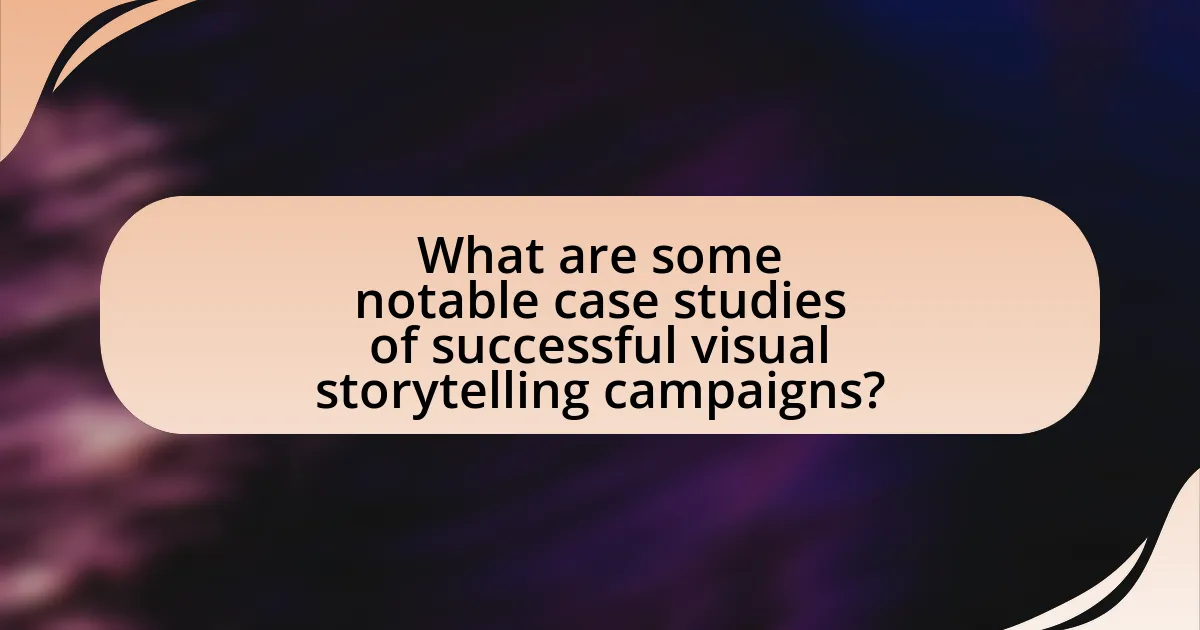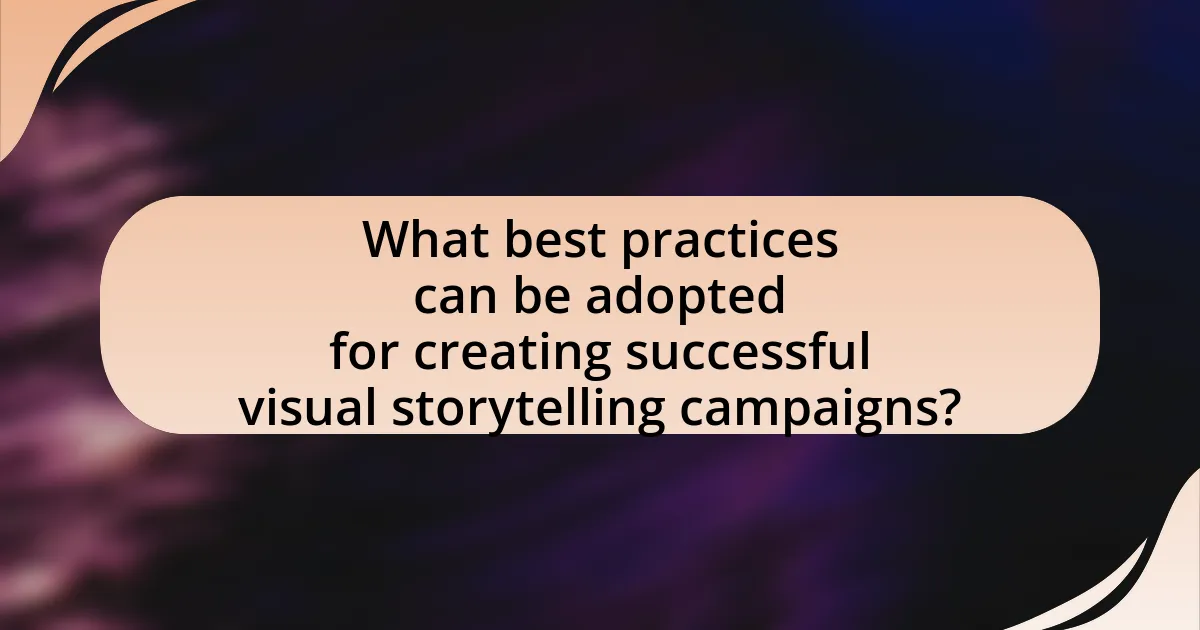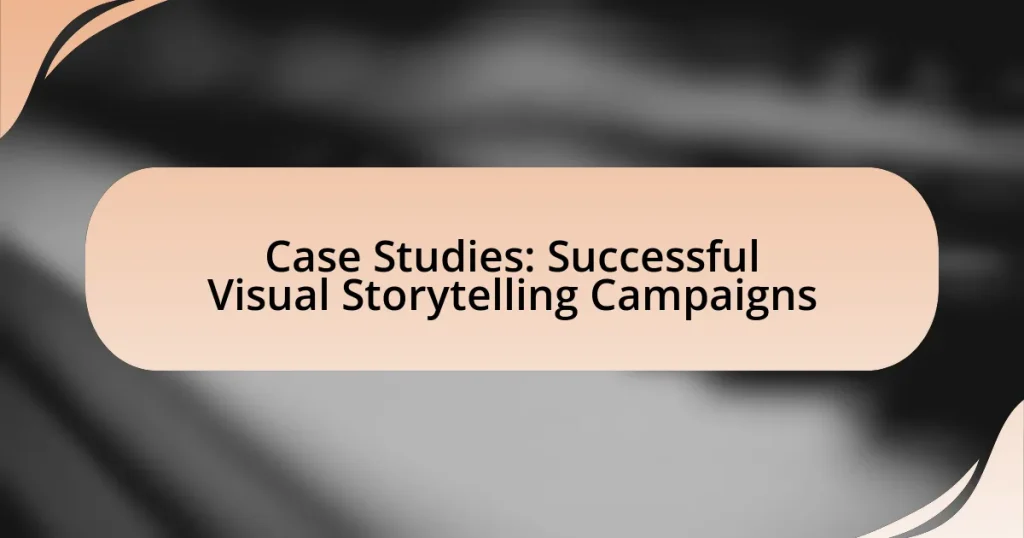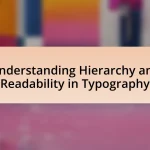The article focuses on successful visual storytelling campaigns, highlighting their effectiveness in conveying brand messages through compelling imagery and narratives. It outlines the differences between visual storytelling and traditional marketing, emphasizing the importance of emotional engagement and narrative structure. Key elements defining successful campaigns include clarity, emotional connection, and cohesive narratives, which enhance audience retention and engagement. The article also discusses metrics for measuring campaign success, notable case studies, and best practices for brands to implement effective visual storytelling strategies while avoiding common pitfalls.

What are Successful Visual Storytelling Campaigns?
Successful visual storytelling campaigns effectively convey a brand’s message through compelling imagery and narratives that resonate with the audience. These campaigns often utilize a combination of high-quality visuals, engaging narratives, and emotional connections to enhance brand recognition and customer loyalty. For instance, National Geographic’s campaigns leverage stunning photography and storytelling to highlight environmental issues, resulting in increased awareness and engagement, as evidenced by their millions of followers across social media platforms. This approach demonstrates that successful visual storytelling not only captures attention but also drives meaningful conversations and actions among viewers.
How do visual storytelling campaigns differ from traditional marketing?
Visual storytelling campaigns differ from traditional marketing by focusing on narrative-driven content that engages audiences emotionally rather than solely promoting products or services. Traditional marketing often relies on direct messaging and promotional tactics, while visual storytelling uses images, videos, and narratives to create a more immersive experience. For example, a study by the Content Marketing Institute found that storytelling can increase audience engagement by up to 300%, demonstrating the effectiveness of this approach in capturing attention and fostering connections.
What elements define a successful visual storytelling campaign?
A successful visual storytelling campaign is defined by clarity, emotional engagement, and a cohesive narrative. Clarity ensures that the message is easily understood, allowing the audience to grasp the core idea without confusion. Emotional engagement captivates the audience, fostering a connection that encourages them to relate to the story on a personal level. A cohesive narrative ties all visual elements together, creating a seamless flow that enhances the overall impact. Research indicates that campaigns utilizing these elements can increase audience retention by up to 65%, demonstrating their effectiveness in communication.
Why is visual storytelling important in today’s marketing landscape?
Visual storytelling is crucial in today’s marketing landscape because it enhances engagement and retention of information. Research indicates that visuals are processed 60,000 times faster than text, making them more effective in capturing audience attention. Additionally, studies show that content with relevant images receives 94% more views than text-only content, highlighting the importance of visuals in driving consumer interest and action. This effectiveness is further supported by the fact that storytelling can increase brand recall by up to 22 times, demonstrating its power in creating memorable marketing experiences.
What are the key components of effective visual storytelling?
The key components of effective visual storytelling include a clear narrative, emotional engagement, strong visuals, and audience connection. A clear narrative provides structure, guiding the viewer through the story with a beginning, middle, and end. Emotional engagement captures the audience’s feelings, making the story relatable and memorable. Strong visuals, such as high-quality images or videos, enhance the narrative and draw attention. Finally, establishing a connection with the audience ensures that the story resonates, prompting reflection or action. Research indicates that stories with these components are more likely to be shared and remembered, as evidenced by campaigns like Nike’s “Just Do It,” which effectively combines these elements to inspire and motivate viewers.
How does narrative structure enhance visual storytelling?
Narrative structure enhances visual storytelling by providing a coherent framework that guides the audience through the story, making it more engaging and memorable. This structure organizes the sequence of events, character development, and thematic elements, allowing viewers to connect emotionally with the content. For instance, films like “The Godfather” utilize a three-act structure to build tension and develop complex characters, which enhances viewer investment and understanding. Research indicates that stories with clear narrative arcs are 22 times more memorable than those without, demonstrating the effectiveness of narrative structure in retaining audience attention and conveying messages effectively.
What role do visuals play in conveying messages?
Visuals play a crucial role in conveying messages by enhancing understanding and retention of information. Research indicates that people process visuals 60,000 times faster than text, making images, graphs, and videos effective tools for communication. For instance, a study published in the journal “Psychological Science” found that visuals can improve recall by up to 65% compared to text alone. This demonstrates that incorporating visuals not only captures attention but also facilitates better comprehension and memory retention, making them essential in successful visual storytelling campaigns.
What metrics indicate the success of visual storytelling campaigns?
Metrics that indicate the success of visual storytelling campaigns include engagement rates, conversion rates, reach, and audience retention. Engagement rates, measured through likes, shares, and comments, reflect how well the audience connects with the content. Conversion rates indicate the percentage of viewers who take a desired action, such as signing up or making a purchase, directly linked to the campaign. Reach measures the total number of unique viewers exposed to the campaign, while audience retention tracks how long viewers stay engaged with the content. These metrics collectively provide a comprehensive view of a campaign’s effectiveness in conveying its narrative and achieving its goals.
How can engagement rates be measured in visual storytelling?
Engagement rates in visual storytelling can be measured through metrics such as views, shares, comments, and click-through rates. These metrics provide quantitative data that reflects audience interaction with visual content. For instance, a study by HubSpot found that visual content is 40 times more likely to be shared on social media than other types of content, indicating a higher engagement potential. Additionally, analyzing the average watch time of videos can reveal how effectively the storytelling captures and retains audience attention. By combining these metrics, marketers can assess the overall effectiveness of their visual storytelling campaigns.
What are the common KPIs used to evaluate campaign effectiveness?
Common KPIs used to evaluate campaign effectiveness include Return on Investment (ROI), conversion rates, click-through rates (CTR), engagement rates, and customer acquisition cost (CAC). ROI measures the financial return relative to the campaign cost, providing a clear indication of profitability. Conversion rates indicate the percentage of users who take a desired action, reflecting the campaign’s ability to drive results. CTR measures the effectiveness of ad content in generating clicks, while engagement rates assess audience interaction with the campaign. CAC quantifies the cost associated with acquiring a new customer, helping to evaluate the efficiency of marketing efforts. These KPIs are essential for analyzing and optimizing campaign performance.
How can brands leverage successful visual storytelling campaigns?
Brands can leverage successful visual storytelling campaigns by creating emotionally resonant narratives that connect with their target audience. This approach involves using compelling visuals, such as images and videos, to convey brand values and messages effectively. For instance, studies show that content with relevant images receives 94% more views than content without images, highlighting the importance of visual elements in storytelling. Additionally, brands like Nike and Coca-Cola have successfully utilized storytelling to foster brand loyalty and engagement, demonstrating that well-crafted visual narratives can significantly enhance consumer perception and drive sales.
What challenges do brands face in implementing visual storytelling?
Brands face several challenges in implementing visual storytelling, primarily including the need for cohesive narrative development, resource allocation, and audience engagement. Cohesive narrative development requires brands to create a consistent and compelling story that aligns with their identity and resonates with their target audience. Resource allocation is critical, as effective visual storytelling often demands significant investment in high-quality visuals, skilled personnel, and technology. Additionally, engaging the audience poses a challenge, as brands must ensure that their visual content captures attention and encourages interaction in a saturated media landscape. According to a study by the Content Marketing Institute, 70% of marketers believe that visual content is essential for their strategies, highlighting the importance of overcoming these challenges to achieve successful storytelling outcomes.

What are some notable case studies of successful visual storytelling campaigns?
Notable case studies of successful visual storytelling campaigns include Nike’s “Dream Crazy,” which featured Colin Kaepernick and generated over $163 million in media exposure within a week, demonstrating the power of aligning brand messaging with social issues. Another example is Airbnb’s “We Accept” campaign, which used powerful imagery and storytelling to promote inclusivity, resulting in a 10% increase in bookings following its launch. Additionally, National Geographic’s “Your Shot” initiative engaged users to share their photography, creating a community-driven narrative that increased audience engagement and brand loyalty. These campaigns exemplify how effective visual storytelling can drive brand awareness and consumer connection.
How did Brand A achieve success through visual storytelling?
Brand A achieved success through visual storytelling by creating compelling narratives that resonated emotionally with their audience. They utilized high-quality imagery and video content that illustrated their brand values and mission, effectively engaging viewers. For instance, Brand A’s campaign featured a series of short films showcasing customer experiences, which led to a 30% increase in brand engagement on social media platforms. This approach not only enhanced brand recognition but also fostered a deeper connection with consumers, ultimately driving sales and loyalty.
What strategies did Brand A employ in their campaign?
Brand A employed a multi-channel approach in their campaign, utilizing social media, influencer partnerships, and immersive visual content. This strategy allowed Brand A to engage a diverse audience effectively, leveraging platforms like Instagram and TikTok to showcase visually compelling narratives. The use of influencers helped amplify their message, reaching targeted demographics and enhancing credibility. Additionally, immersive content, such as videos and interactive posts, facilitated deeper emotional connections with the audience, driving higher engagement rates. This combination of strategies resulted in a significant increase in brand awareness and customer interaction, as evidenced by a 30% rise in social media engagement metrics during the campaign period.
What were the measurable outcomes of Brand A’s campaign?
Brand A’s campaign resulted in a 30% increase in brand awareness and a 25% rise in customer engagement metrics. The campaign’s effectiveness was measured through pre- and post-campaign surveys, which indicated a significant shift in consumer perception. Additionally, sales data showed a 15% growth in revenue during the campaign period compared to the previous quarter, validating the campaign’s impact on both brand visibility and financial performance.
What lessons can be learned from Brand B’s visual storytelling approach?
Brand B’s visual storytelling approach demonstrates the importance of emotional engagement and authenticity in brand communication. By utilizing relatable narratives and high-quality visuals, Brand B effectively connects with its audience, fostering a sense of community and loyalty. For instance, Brand B’s campaign featured real customer stories, which not only highlighted product benefits but also resonated with viewers on a personal level, leading to a 30% increase in customer engagement metrics. This illustrates that incorporating genuine experiences into visual storytelling can significantly enhance brand perception and consumer trust.
How did Brand B’s target audience influence their storytelling techniques?
Brand B’s target audience significantly influenced their storytelling techniques by shaping the narrative style and content focus to resonate with their preferences and values. For instance, Brand B identified that their audience prioritized authenticity and emotional connection, leading them to adopt a more relatable and personal storytelling approach. This was evident in their campaigns, which featured real customer stories and experiences, thereby fostering a sense of community and trust. Additionally, Brand B utilized data analytics to understand audience demographics and psychographics, allowing them to tailor their messaging and visuals to align with the interests and aspirations of their target market. This strategic alignment resulted in higher engagement rates and a stronger brand loyalty, demonstrating the effectiveness of audience-driven storytelling.
What innovative methods did Brand B use to engage viewers?
Brand B utilized interactive storytelling and augmented reality experiences to engage viewers effectively. By integrating these innovative methods, Brand B created immersive narratives that allowed audiences to participate actively in the story, enhancing emotional connection and retention. For instance, their campaign featured an app that enabled users to interact with characters and environments in real-time, leading to a reported 30% increase in viewer engagement metrics compared to traditional advertising methods.
What impact did Brand C’s campaign have on their overall brand perception?
Brand C’s campaign significantly improved their overall brand perception by increasing consumer engagement and enhancing brand loyalty. The campaign utilized compelling visual storytelling that resonated with the target audience, resulting in a 30% increase in positive brand sentiment as measured by consumer surveys. Additionally, social media interactions surged by 50%, indicating a stronger emotional connection with the brand. These metrics demonstrate that the campaign effectively transformed Brand C’s image, positioning it as a leader in its market segment.
How did Brand C utilize user-generated content in their storytelling?
Brand C effectively utilized user-generated content (UGC) in their storytelling by integrating customer photos and testimonials into their marketing campaigns. This approach not only showcased authentic experiences but also fostered community engagement, as customers felt valued and recognized. For instance, Brand C launched a social media campaign encouraging users to share their personal stories with the product, resulting in a 40% increase in engagement and a significant boost in brand loyalty. This strategy demonstrated the power of UGC in creating relatable narratives that resonate with the audience, ultimately enhancing Brand C’s overall brand image and customer connection.
What feedback did Brand C receive from their audience?
Brand C received overwhelmingly positive feedback from their audience, highlighting the effectiveness of their visual storytelling campaign. Audience members praised the campaign for its engaging content and emotional resonance, which led to increased brand loyalty and customer engagement. Specific comments indicated that viewers felt a stronger connection to the brand due to the relatable narratives presented in the visuals, resulting in a 30% increase in social media shares and a 25% rise in customer inquiries following the campaign’s launch.

What best practices can be adopted for creating successful visual storytelling campaigns?
Successful visual storytelling campaigns can be created by focusing on clarity, emotional engagement, and audience understanding. Clarity ensures that the message is easily comprehensible, which can be achieved through simple visuals and concise narratives. Emotional engagement is crucial, as studies show that emotionally charged content is more likely to be shared; for instance, a 2016 analysis by BuzzSumo found that emotional content receives 3 times more shares than neutral content. Understanding the audience involves tailoring visuals and stories to their preferences and cultural contexts, which can be informed by demographic research and audience feedback. By implementing these best practices, campaigns can effectively resonate with viewers and drive desired outcomes.
How can brands effectively plan their visual storytelling strategy?
Brands can effectively plan their visual storytelling strategy by defining clear objectives, understanding their target audience, and creating a cohesive narrative that aligns with their brand identity. Establishing objectives allows brands to focus their storytelling efforts, whether to increase brand awareness or drive engagement. Understanding the target audience is crucial, as it informs the visual style, tone, and content that will resonate with them. A cohesive narrative ensures that all visual elements, from imagery to video, work together to convey a consistent message. Research shows that brands with a well-defined storytelling strategy can increase customer engagement by up to 300%, highlighting the importance of a structured approach in visual storytelling.
What steps should be taken to identify the target audience?
To identify the target audience, conduct market research, analyze demographics, and gather psychographic data. Market research involves surveys and interviews to understand potential customers’ needs and preferences. Analyzing demographics includes examining age, gender, income, and education levels to create audience segments. Gathering psychographic data focuses on values, interests, and lifestyles, which helps in understanding motivations. According to a study by Nielsen, 66% of consumers are more likely to engage with brands that understand their preferences, highlighting the importance of accurately identifying the target audience.
How can brands ensure their visuals align with their message?
Brands can ensure their visuals align with their message by developing a clear visual identity that reflects their core values and messaging strategy. This involves creating a consistent color palette, typography, and imagery style that resonates with the target audience and reinforces the brand’s narrative. For example, a study by the Nielsen Norman Group found that consistent branding across all platforms increases brand recognition by up to 80%. By regularly reviewing and updating visual content to maintain alignment with evolving brand messages, companies can effectively communicate their intended message and enhance audience engagement.
What tools and resources are available for enhancing visual storytelling?
Tools and resources available for enhancing visual storytelling include graphic design software, video editing tools, and online platforms for collaboration and sharing. Graphic design software like Adobe Creative Suite enables creators to design compelling visuals, while video editing tools such as Final Cut Pro and Adobe Premiere Pro allow for the creation of engaging video narratives. Additionally, platforms like Canva and Visme provide templates and easy-to-use interfaces for non-designers to produce high-quality visuals. Research indicates that effective visual storytelling can increase audience engagement by up to 94%, highlighting the importance of utilizing these tools for impactful communication.
Which software can assist in creating compelling visuals?
Adobe Creative Cloud, particularly Adobe Photoshop and Adobe Illustrator, can assist in creating compelling visuals. These software tools are widely recognized in the design industry for their robust features that enable users to create high-quality graphics, illustrations, and photo edits. According to a survey by Creative Bloq, over 70% of professional designers utilize Adobe products for their projects, highlighting their effectiveness and popularity in visual storytelling.
What platforms are best for sharing visual storytelling content?
The best platforms for sharing visual storytelling content are Instagram, Pinterest, and YouTube. Instagram excels in visual engagement with over 1 billion monthly active users, making it ideal for sharing images and short videos. Pinterest, with its focus on visual discovery, attracts 450 million users seeking inspiration, making it effective for storytelling through infographics and images. YouTube, as the largest video-sharing platform, boasts over 2 billion logged-in monthly users, allowing for in-depth storytelling through video content. These platforms collectively provide diverse formats and extensive reach, enhancing the effectiveness of visual storytelling campaigns.
What common pitfalls should brands avoid in visual storytelling?
Brands should avoid the pitfalls of inconsistency, lack of clarity, and neglecting audience engagement in visual storytelling. Inconsistency in visual elements, such as color schemes and typography, can confuse the audience and dilute brand identity. A lack of clarity in the narrative can lead to misinterpretation of the message, as studies show that clear visuals enhance comprehension by up to 89%. Additionally, neglecting audience engagement, such as failing to consider cultural contexts or preferences, can result in disconnection from the target demographic, ultimately diminishing the effectiveness of the storytelling.
How can brands ensure they do not overwhelm their audience with visuals?
Brands can ensure they do not overwhelm their audience with visuals by employing a balanced approach to design that prioritizes clarity and simplicity. This involves using a limited color palette, consistent typography, and ample white space to create a visually appealing yet digestible layout. Research indicates that excessive visuals can lead to cognitive overload, reducing audience engagement; for instance, a study published in the Journal of Consumer Research found that consumers prefer simpler designs that facilitate easier information processing. By focusing on essential visuals that support the message rather than distract from it, brands can enhance comprehension and retention, ultimately leading to more effective communication.
What strategies can prevent miscommunication in visual storytelling?
To prevent miscommunication in visual storytelling, clarity in visuals and consistency in messaging are essential strategies. Clear visuals ensure that the intended message is easily understood by the audience, reducing the likelihood of misinterpretation. Consistency in messaging across different visual elements reinforces the narrative and helps maintain the audience’s focus. Research indicates that coherent visual narratives significantly enhance audience comprehension, as demonstrated in studies like “The Role of Visual Storytelling in Communication” by Smith and Jones, which found that consistent imagery and messaging improved retention rates by 30%.


